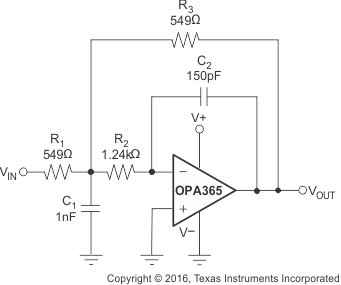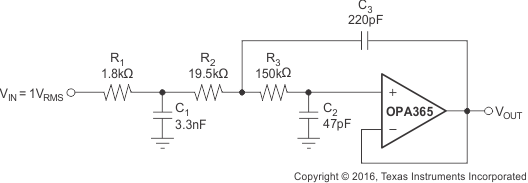SBOS365G may 2006 – may 2023 OPA2365 , OPA365
PRODUCTION DATA
- 1
- 1 Features
- 2 Applications
- 3 Description
- 4 Revision History
- 5 Device Comparison Table
- 6 Pin Configuration and Functions
- 7 Specifications
- 8 Detailed Description
- 9 Application and Implementation
- 10Device and Documentation Support
- 11Mechanical, Packaging, and Orderable Information
Package Options
Mechanical Data (Package|Pins)
Thermal pad, mechanical data (Package|Pins)
Orderable Information
8.3.5 Active Filtering
The OPAx365 are an excellent choice for active filter applications requiring a wide bandwidth, fast slew rate, low-noise, single-supply operational amplifier. Figure 8-5 shows a 500-kHz, second-order, low-pass filter using the multiple-feedback (MFB) topology. The components have been selected to provide a maximally-flat Butterworth response. Beyond the cutoff frequency, rolloff is −40 dB/dec. The Butterworth response is great for applications requiring predictable gain characteristics such as the antialiasing filter used ahead of an ADC.
 Figure 8-5 Second-Order Butterworth, 500-kHz Low-Pass Filter
Figure 8-5 Second-Order Butterworth, 500-kHz Low-Pass FilterOne point to observe when considering the MFB filter is that the output is inverted, relative to the input. If this inversion is not required, or not desired, a noninverting output can be achieved through one of these options:
- Add an inverting amplifier.
- Add an additional second-order MFB stage.
- Use a noninverting filter topology such as Sallen-Key.
The Sallen-Key topology is shown in Figure 8-6.
 Figure 8-6 Configured as a Three-Pole, 20-kHz, Sallen-Key Filter
Figure 8-6 Configured as a Three-Pole, 20-kHz, Sallen-Key Filter